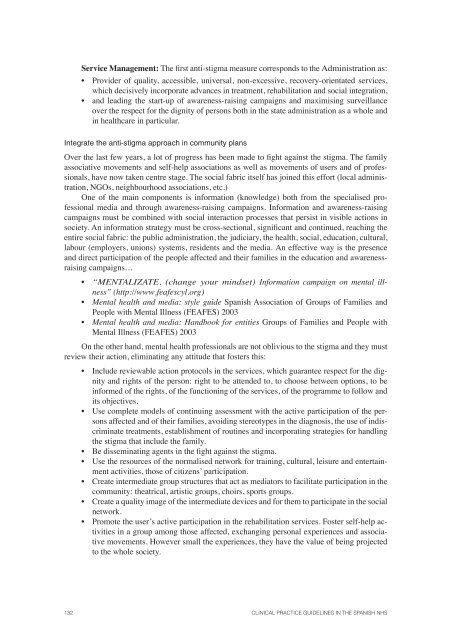CPG for Psychosocial Interventions in Severe Mental ... - GuÃaSalud
CPG for Psychosocial Interventions in Severe Mental ... - GuÃaSalud
CPG for Psychosocial Interventions in Severe Mental ... - GuÃaSalud
You also want an ePaper? Increase the reach of your titles
YUMPU automatically turns print PDFs into web optimized ePapers that Google loves.
Service Management: The first anti-stigma measure corresponds to the Adm<strong>in</strong>istration as:<br />
• Provider of quality, accessible, universal, non-excessive, recovery-orientated services,<br />
which decisively <strong>in</strong>corporate advances <strong>in</strong> treatment, rehabilitation and social <strong>in</strong>tegration,<br />
• and lead<strong>in</strong>g the start-up of awareness-rais<strong>in</strong>g campaigns and maximis<strong>in</strong>g surveillance<br />
over the respect <strong>for</strong> the dignity of persons both <strong>in</strong> the state adm<strong>in</strong>istration as a whole and<br />
<strong>in</strong> healthcare <strong>in</strong> particular.<br />
Integrate the anti-stigma approach <strong>in</strong> community plans<br />
Over the last few years, a lot of progress has been made to fight aga<strong>in</strong>st the stigma. The family<br />
associative movements and self-help associations as well as movements of users and of professionals,<br />
have now taken centre stage. The social fabric itself has jo<strong>in</strong>ed this ef<strong>for</strong>t (local adm<strong>in</strong>istration,<br />
NGOs, neighbourhood associations, etc.)<br />
One of the ma<strong>in</strong> components is <strong>in</strong><strong>for</strong>mation (knowledge) both from the specialised professional<br />
media and through awareness-rais<strong>in</strong>g campaigns. In<strong>for</strong>mation and awareness-rais<strong>in</strong>g<br />
campaigns must be comb<strong>in</strong>ed with social <strong>in</strong>teraction processes that persist <strong>in</strong> visible actions <strong>in</strong><br />
society. An <strong>in</strong><strong>for</strong>mation strategy must be cross-sectional, significant and cont<strong>in</strong>ued, reach<strong>in</strong>g the<br />
entire social fabric: the public adm<strong>in</strong>istration, the judiciary, the health, social, education, cultural,<br />
labour (employers, unions) systems, residents and the media. An effective way is the presence<br />
and direct participation of the people affected and their families <strong>in</strong> the education and awarenessrais<strong>in</strong>g<br />
campaigns…<br />
• “MENTALIZATE. (change your m<strong>in</strong>dset) In<strong>for</strong>mation campaign on mental illness”<br />
(http://www.feafescyl.org)<br />
• <strong>Mental</strong> health and media: style guide Spanish Association of Groups of Families and<br />
People with <strong>Mental</strong> Illness (FEAFES) 2003<br />
• <strong>Mental</strong> health and media: Handbook <strong>for</strong> entities Groups of Families and People with<br />
<strong>Mental</strong> Illness (FEAFES) 2003<br />
On the other hand, mental health professionals are not oblivious to the stigma and they must<br />
review their action, elim<strong>in</strong>at<strong>in</strong>g any attitude that fosters this:<br />
• Include reviewable action protocols <strong>in</strong> the services, which guarantee respect <strong>for</strong> the dignity<br />
and rights of the person: right to be attended to, to choose between options, to be<br />
<strong>in</strong><strong>for</strong>med of the rights, of the function<strong>in</strong>g of the services, of the programme to follow and<br />
its objectives.<br />
• Use complete models of cont<strong>in</strong>u<strong>in</strong>g assessment with the active participation of the persons<br />
affected and of their families, avoid<strong>in</strong>g stereotypes <strong>in</strong> the diagnosis, the use of <strong>in</strong>discrim<strong>in</strong>ate<br />
treatments, establishment of rout<strong>in</strong>es and <strong>in</strong>corporat<strong>in</strong>g strategies <strong>for</strong> handl<strong>in</strong>g<br />
the stigma that <strong>in</strong>clude the family.<br />
• Be dissem<strong>in</strong>at<strong>in</strong>g agents <strong>in</strong> the fight aga<strong>in</strong>st the stigma.<br />
• Use the resources of the normalised network <strong>for</strong> tra<strong>in</strong><strong>in</strong>g, cultural, leisure and enterta<strong>in</strong>ment<br />
activities, those of citizens’ participation.<br />
• Create <strong>in</strong>termediate group structures that act as mediators to facilitate participation <strong>in</strong> the<br />
community: theatrical, artistic groups, choirs, sports groups.<br />
• Create a quality image of the <strong>in</strong>termediate devices and <strong>for</strong> them to participate <strong>in</strong> the social<br />
network.<br />
• Promote the user’s active participation <strong>in</strong> the rehabilitation services. Foster self-help activities<br />
<strong>in</strong> a group among those affected, exchang<strong>in</strong>g personal experiences and associative<br />
movements. However small the experiences, they have the value of be<strong>in</strong>g projected<br />
to the whole society.<br />
132 CLINICAL PRACTICE GUIDELINES IN THE SPANISH NHS

















